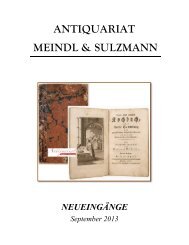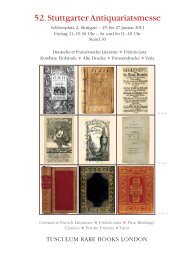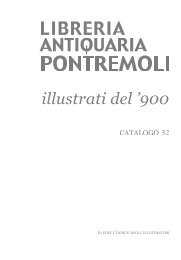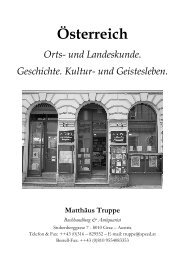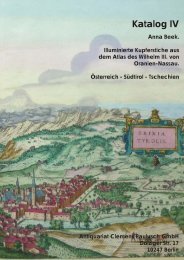Japanese Prints
Japanese Prints
Japanese Prints
Create successful ePaper yourself
Turn your PDF publications into a flip-book with our unique Google optimized e-Paper software.
72<br />
Glossary<br />
Azalea<br />
A symbol of temperance, passion and womanhood.<br />
Bamboo<br />
Growing wild throughout Japan, bamboo has long been used in a<br />
variety of ways, from food source to building material. It is an<br />
auspicious plant, and in the Orient is linked with confucian human<br />
virtues. Its evergreen leaves connote ‘constancy’, the evenly spread<br />
nodes signify ‘moderation’, and its bending in the wind implies<br />
‘moral resilience’. combined with animals it has several meanings.<br />
for example, bamboo and the sparrow together signify friendship,<br />
while the bamboo and the tiger imply safety. An image of bamboo<br />
reminds us to be resilient and to stand upright against obstacles.<br />
Bat<br />
A symbol of prosperity and happiness that was imported from<br />
china. The characters for ‘bat’ and ‘good luck’ are pronounced alike<br />
in chinese and <strong>Japanese</strong>.<br />
Boat<br />
It is said that sailing boats bring wealth from beyond the ocean. The<br />
seven lucky gods are often depicted on a treasure ship, a symbol of<br />
good fortune.<br />
Bridge<br />
Signifies a route blessed to take to salvation. A zigzag bridge<br />
prevents evil spirits from crossing, since it was believed ghosts and<br />
evil spirits could only move in straight lines.<br />
Buddha Statue<br />
represents mercy and enlightenment. Statues or images of Buddha<br />
are used as talismans against evil.<br />
Butterfly<br />
Symbolising spring, they are associated with happiness and joy.<br />
favoured for the dual nature of its delicate and elegant symmetry,<br />
and its transcendent evolution from a lowly caterpillar to noble<br />
insect, the butterfly also signifies metamorphosis or transformation.<br />
In <strong>Japanese</strong> lore souls and spirits take the shape of a butterfly,<br />
therefore they are seen as the personification of a dead or living<br />
person’s soul. Often associated with traditional Shinto weddings,<br />
two butterflies dancing about one another symbolise marital<br />
happiness.<br />
Camellia<br />
The camellia is known as the flower that brings spring. It has long<br />
been regarded as a symbol of longevity, love, happy marriage,<br />
fortune, victory and happiness.<br />
Camphor trees<br />
Often gracing Shinto shrines, their stature, compelling aroma, and<br />
long life provide an appropriate symbolic meaning of longevity and<br />
good fortune.<br />
Canna<br />
The flower of passion and respect.<br />
Carp<br />
drawing on a chinese legend of a fish so strong and persistent that<br />
it could leap a waterfall, the Koi’s determination to overcome<br />
obstacles is held to be a fitting example of ambition, strength and<br />
the will to overcome difficulties. With the power to fight its way up<br />
swift streams, it symbolises persistence, bravery and strength as well<br />
as surpassing expectations. It therefore embodies the attributes<br />
desired in boys. The boys’ festival is celebrated on the 5th day of<br />
the 5th month. Balloon carps are hoisted on a long pole set in the<br />
garden or attached to the roof of the house. Usually a carp is flown<br />
for each son. Koi swimming upstream are also interpreted as<br />
showing the philosophy of non-conformism since they do not “go<br />
with the flow”. This signifies independence of the mind. Since they<br />
can live for centuries, Koi are also a symbol of immortality.<br />
Castle<br />
The castle demonstrated the political and military strength and<br />
wealth of the samurais and feudal lords. It is now recognised as a<br />
symbol of strength.<br />
Cat<br />
Statues or images of cats are often placed in <strong>Japanese</strong> shops and<br />
businesses as a lucky charm, in the hope that the establishment will<br />
prosper. The most popular kind of lucky charm in <strong>Japanese</strong> stores<br />
is a figurine which has the shape of a cat waving its paw; the<br />
“Maneki neko”. The cat whether it keeps away pests or attracts<br />
customers, symbolises success and good fortune.









